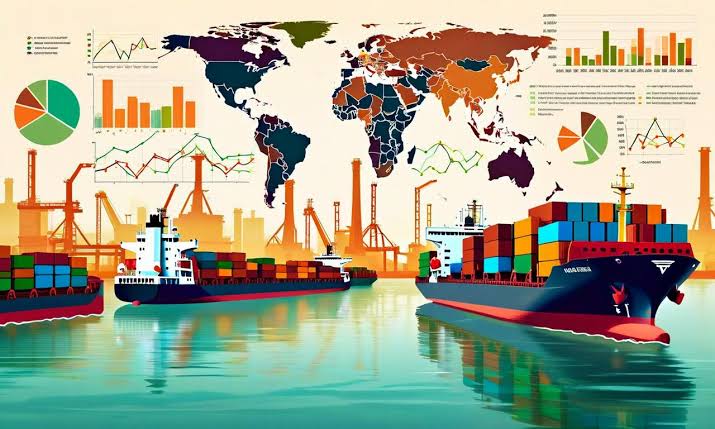India's July 2025 economic report reveals a complex interplay of trade dynamics amid rising US tariffs, ongoing negotiations, and strategic trade diversification efforts. While the immediate effect of US tariffs on Indian exports appears limited, the secondary and tertiary impacts on the broader economy present significant challenges. This newsletter delves into India's current economic landscape, trade responses, and future outlook amid these pressures.
Key Economic Highlights for July 2025
-
India's total exports (merchandise and services combined) in July stood at USD 68.27 billion, marking a healthy 4.2% year-on-year growth. Imports rose by 6.07% to USD 79.99 billion, reflecting a widening trade deficit.
-
Inflation dropped to a historic low of 1.55% in July 2025, easing cost pressures for consumers and businesses.
-
India's manufacturing activity and services sector expanded robustly in July, supported by strong domestic demand.
-
The government collected Rs. 1.96 lakh crore in GST revenues, a 7.5% increase over the previous year, highlighting sustained consumption.
-
The UPI system set new records with nearly 1,947 crore transactions valued at Rs. 25.1 lakh crore, indicating deepening digital economic activity .
Immediate Impact of US Tariffs on Indian Exports
Starting August 27, 2025, the United States implemented steep tariffs up to 50% on a wide array of Indian goods, including textiles, gems and jewelry, footwear, furniture, and industrial chemicals. These tariffs will directly affect approximately 66% of India’s exports to the US, valued at $86.5 billion annually .
Though the tariff hike’s immediate impact is slowed by some exemptions and transit protections for shipments already en route, the outlook warns of a potential 40-45% drop in merchandise exports to the US during fiscal year 2025-26. Specific sectors face volume declines of up to 70%, risking hundreds of thousands of jobs, especially in labor-intensive industries and MSMEs that operate on thin margins .
India-US Trade Negotiations: Critical to Mitigating Damage
India is pressing ahead with trade talks despite looming tariffs, seeking to secure a broader bilateral trade deal expected by autumn 2025 (between mid-September and December). Negotiators emphasize a long-term economic partnership beyond short-term tariff disruptions .
Key challenges in talks include:
-
The US demand for immediate elimination of customs duties on American imports.
-
India’s sustained resistance to opening sensitive sectors like agriculture and dairy.
-
India’s focus on tariff staging, phasing out duties gradually rather than immediate removal .
-
Officials describe the tariff imposition as possibly temporary, with ongoing negotiations seen as vital to reversing or softening tariffs and sustaining trade flows .
India’s Diversified Trade Strategy: A Long-Term Buffer
To offset risks related to the US tariff scenario, India is actively pursuing market diversification via multiple free trade agreements (FTAs) and strategic trade pacts, including:
The recently signed India-EFTA Trade Deal facilitating duty-free market access in Europe.
Strengthened trade ties with ASEAN and African countries.
Shifting export focus from low-margin bulk goods to value-added, specialty products in chemicals, pharmaceuticals, and engineering sectors .
Government initiatives such as Production-Linked Incentives (PLI), Remission of Duties and Taxes on Exported Products (RoDTEP), and digital trade missions support exporters in improving global competitiveness .
However, these diversification efforts are complex and time-consuming. Analysts caution that while helpful, these initiatives may not fully compensate for the shortfall in US exports if the tariff rates persist over an extended period.
Secondary and Tertiary Economic Challenges
The increased tariffs indirectly strain India’s economy by pressuring employment in export-dependent sectors and dampening investor confidence. MSMEs, which contribute nearly 45% of India’s exports and dominate affected sectors, face disproportionate stress due to their limited financial flexibility .
Exports' volume declines could ripple through supply chains, affecting ancillary industries and regional economies reliant on trade activities. These secondary effects complicate macroeconomic management, despite positive domestic indicators like low inflation and resilient consumption .
Key Takeaways
-
While immediate disruption from US tariffs is somewhat contained, significant downstream impacts threaten export volumes, jobs, and MSME viability.
-
Successful ongoing India-US trade negotiations are crucial to reversing tariffs or securing alternative arrangements to restore market access.
-
India’s diversified trade strategy and government support programs provide essential long-term resilience but will require time to fully mitigate US tariff risks.
-
Policymakers must balance short-term economic pressures against medium-to-long-term structural reforms to sustain India’s growth trajectory amid global trade uncertainties.
This report combines government data, trade analyses, and expert insights as of August 27, 2025, highlighting the nuanced reality behind headline export numbers and trade relations during this critical economic juncture.
Source: Economic Times BFSI, PIB India, Bloomberg Reuters, Global Trade Research Initiative, Al Jazeera, India Briefing, Deloitte Insights, Swastika International
